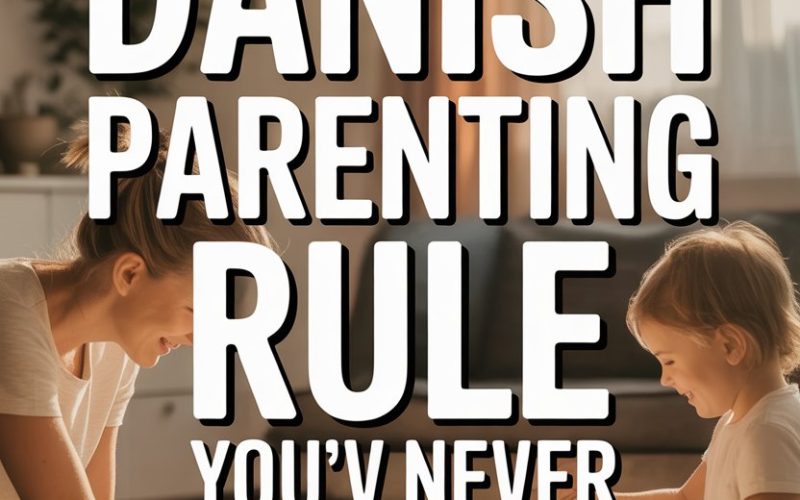Ever wonder how Danes manage to raise such unflappable little humans, even when the sky’s as grey as porridge and it rains sideways for six months straight?
Sure, there’s something in the smørrebrød, but there’s also a parenting trick so simple—and so radical by North American standards—that most busy parents haven’t even considered it.
Prepare to meet “hygge”—the slightly unpronounceable Danish word that just might save your frazzled evenings and fix your family’s connection, one hot chocolate at a time.
Hygge Is Not Just Candles and Cake
Before you start stockpiling cinnamon buns and lighting IKEA candles in every room, let’s clear up a common misconception: hygge isn’t just about aesthetics.
Yes, Danes love a good candle (Denmark burns more candles per capita than anywhere on earth), but hygge runs deeper.
Pronounced “hoo-gah,” it describes a feeling of cozy togetherness, safety, and contentment—like being wrapped in your favourite jumper on a chilly day, but for your soul.
And here’s the kicker: Danes work hard at hygge. It’s not just a vibe that floats through the air with the scent of cardamom buns.
Families intentionally create space for it, especially when things are stressful or everyone’s been staring at screens until their eyeballs twitch.
The Hygge Rule in Action: No Drama Allowed
This is where the #1 Danish parenting rule blows most of our frazzled routines out of the water: during hygge time, all drama stays at the door.
Did your older child swipe the remote? Did you and your partner squabble about dishwasher logistics for the tenth time this week? Even if your toddler is mid-meltdown, the rule reigns: no arguments, negativity, or big decisions.
Everyone agrees to set their grievances aside—for just a little while.
Dr. Iben Sandahl, Danish psychotherapist and co-author of The Danish Way of Parenting, says, “Hygge is a sanctuary from daily hassles.
The family comes together, even if for 20 minutes, to reconnect and slow down. No one brings complaints to the table.”
Think of it as Switzerland for your family’s emotions—neutral territory, now serving cocoa.
Yes, You’re Busy—Here’s How to Make Hygge Work Anyway
There’s no need to block out three hours and orchestrate a Pinterest-worthy scene. Danes actually keep it simple.
Set aside a few minutes—after dinner, before bedtime, or whenever the house feels like it’s one tantrum away from chaos. Phones go away (this one’s non-negotiable). TV gets switched off, unless you’re all snuggling up for a movie together.
It could be as minimal as everyone piling onto the couch with blankets, sharing some biscuits, and talking about the day.
Or maybe you read a book aloud, play a board game, or just sit in companionable silence while the dog snores and your youngest tries to stick raisins up their nose.
The magic comes from shared presence, not elaborate plans.
The No-Drama Pact: How to Enforce It Without Eye Rolls
Expect some skepticism, especially from tweens. (“Wait, you mean we’re not going to argue for a WHOLE twenty minutes?”) But make it a game.
Agree as a family: during hygge time, nobody brings up anything stressful. Not school, work emails, who didn’t feed the guinea pig. If someone forgets, gently remind them: “Save it for later—this is our hygge zone.”
Some Danish families even light a “hygge candle”—if anyone starts to argue, the candle “goes out,” and so does the special moment. It’s a signal, not a punishment.
Over time, even the most reluctant participant comes to crave the peace.
Science Backs It Up (Yes, Even the Raisin Thing)
Research supports what Danish parents have known for generations: shared positive routines reduce stress, boost social skills, and help kids self-regulate their emotions.
In fact, a 2016 study found that family rituals—even tiny ones, like bedtime stories or pancake Sundays—create security and belonging for children.
That sense of ritual is powerful. It’s not about perfection. It’s about predictability: your kids know that no matter how wild the week gets, there’s always a pocket of calm coming.
And if calm arrives in the form of sticky fingers and a slightly squished raisin, well, even better.
What Hygge Is Not
This is not forced fun. No one has to perform, make crafts, or wear matching reindeer socks.
It’s not about escaping real life or ignoring problems forever. The dishwasher will need fixing and your child will indeed need to apologise for drawing on the walls. Just not right now.
Hygge is a pause button. An amnesty. A chance to remind each other you actually like being a family, even when laundry is breeding in the hall.
Hygge for the Truly Time-Starved
Short on time? Even five minutes counts.
Try a “hygge snack attack.” Everyone grabs a biscuit, sits together, and shares something funny that happened during the day.
Or keep a basket of conversation cards handy—each person picks one and answers: “What’s the silliest thing you’ve ever eaten?” “Who would win in a dance battle: Mum or the cat?”
No need to overthink it. The key is presence and a shared agreement to press pause on chaos.
Why Kids (and Parents) Crave This Rule
Modern life has convinced us that quality time needs to happen on a schedule, after we’ve finished all our chores and sorted out world peace. Spoiler: that day rarely comes.
What Danish parents have recognised is that connection doesn’t wait for the stars to align. It happens in the messy, snack-filled gaps of regular days.
When you make hygge a family ritual, you show your kids that peace and togetherness aren’t things you have to earn. They’re part of the daily routine—like brushing teeth, but with more carbs.
The result? Kids who are more resilient, empathetic, and (just maybe) better at switching off their own drama when it counts.
The Candle’s Still Burning
Before you rush off to buy a year’s supply of tea lights, remember: the spirit of hygge is less about what you do and more about how you do it.
Tonight, when everyone’s home and the evening threatens to unravel, try this Danish rule. Declare a drama-free zone, pile onto the sofa, and share a biscuit or a story.
No need for Instagram-worthy setups—just a pocket of warmth in the middle of the usual storm.
You might be surprised by how much calmer bedtime feels. Or how suddenly, your kids want to linger on the couch instead of sprinting to their screens.
And if, by the faint candlelight, someone confesses to drawing on the walls?
Well, at least you’ll have a warm cup of cocoa in hand when you deal with it—later.





